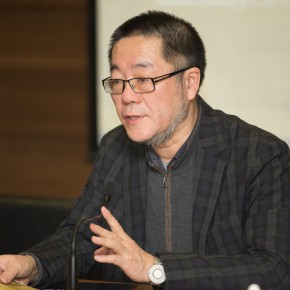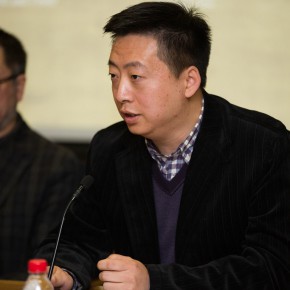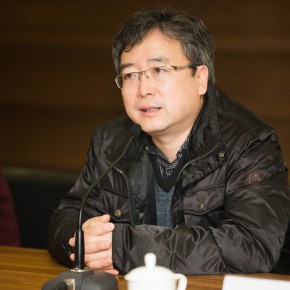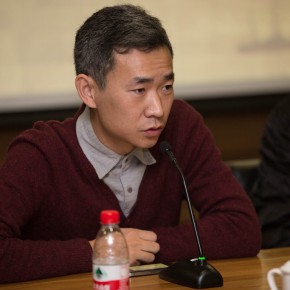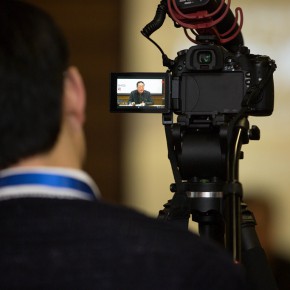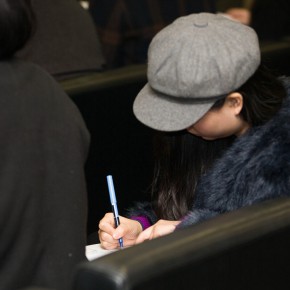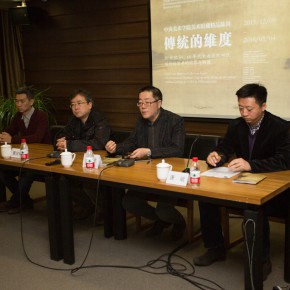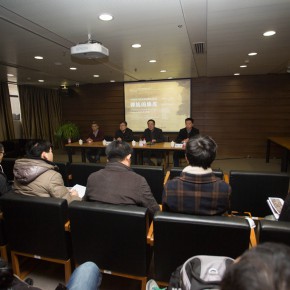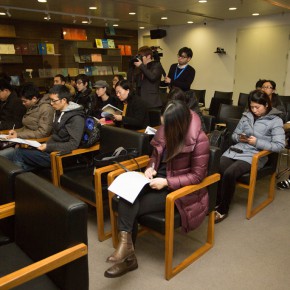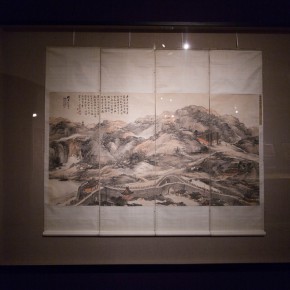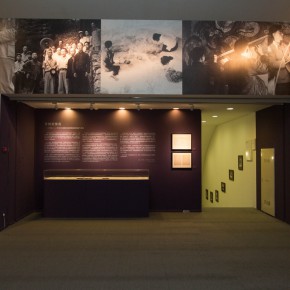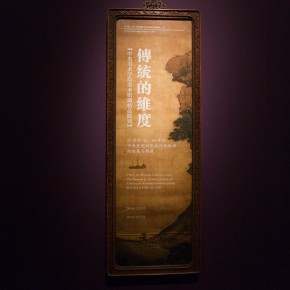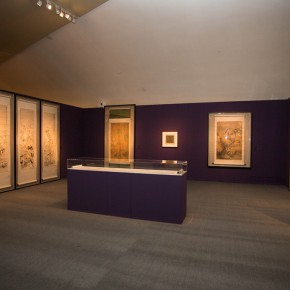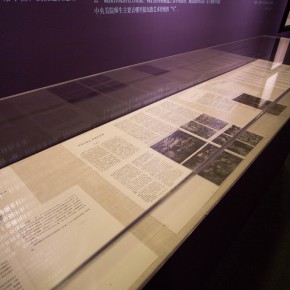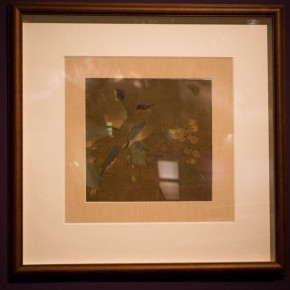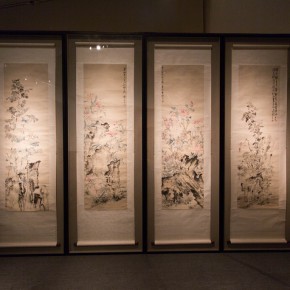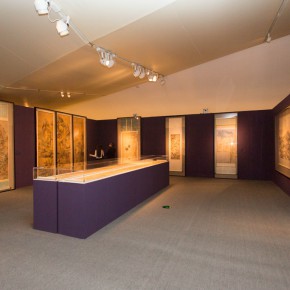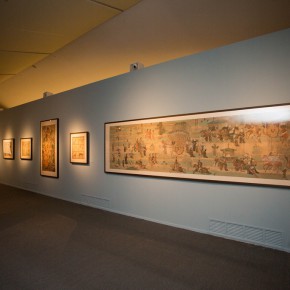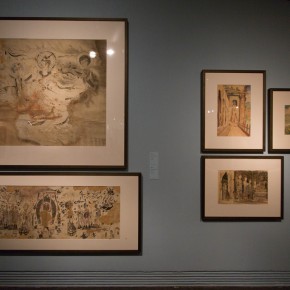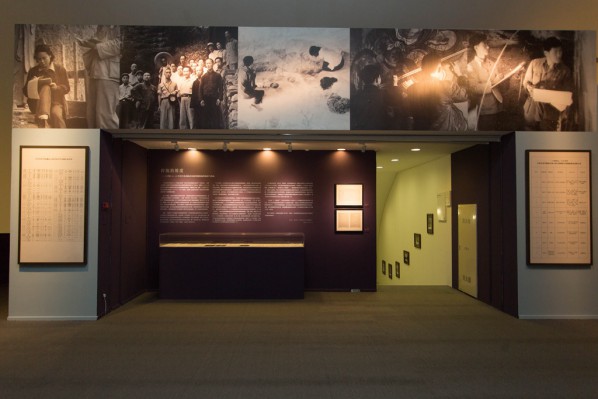
On December 9, 2015, “The Dimension of Tradition – Copying and the Collection for the National Traditional Painting by CAFA in the 1950s and 1960s” opened at CAFA Art Museum. It is the 4th round of the CAFA Art Museum Collection Series, following CAFA Art Museum Collection Series: Selected Works of Chinese Painting Created in the Period of the National Beiping Art School, Selected Works in Oil Painting Created in the Period of the National Beiping Art School and Merging – From National Beiping Art School, Yan’an Luxun Academy of Literature and Art to CAFA (1946-1953), to research the history of CAFA and the academic tradition from the perspective of the collections of CAFA Art Museum again. Director of CAFA Art Museum Wang Huangsheng acts as the Academic Director and it continues to be planned by the Associate Professor of CAFA Cao Qinghui.
At 10:00 am, Director of CAFA Art Museum Wang Huangsheng and Deputy Director Tang Bin, Director of the Collection Department Li Yaochen, the exhibition curator Cao Qinghui attended the press conference of the exhibition, to share with the media the original idea of the exhibition, exhibition architecture and the general plan of the collection of study by the art museum, etc.
As an art museum of the academy, CAFA Art Museum has attached great importance to the systematic carding and academic research of collections, since it participated in the National Exhibition Season of the Brilliant Collection from the Art Museum in China organized by the Ministry of Culture in 2012, it has mobilized the academic strengths of the whole academy, to continuously launch a series of study exhibitions based on the carding of the evolution of the history of the academy and the spiritual tradition, which was commended as an “outstanding exhibition” by the National Exhibition Season of the Brilliant Collection from the Art Museum in China organized by the Ministry of Culture. On April 1, 1950, CAFA was formally established, which was closely connected with Chinese literary demand, under the guidance of the big guiding principles for literature and art, it built its own teaching system, cultivated art talent, from which there are many academic topics to discuss. Curator Cao Qinghui said that, in the early period of the founding of new China, the “transformation of Chinese painting” was the trend of the discussion of literature and art, which actually focused on how we have come to know the national traditional painting. Therefore the exhibition focuses on CAFA’s attitude to tradition in the 1950s and 1960s, and the related measures, which are the two themes of the exhibition: going out and coming in.
When CAFA was first established in the 1950s and 1960s, the teachers and students of the academy positively travelled out of the campus and entered the caves, palaces, temples and tombs that had been preliminarily scientifically protected and cleared up, copying the mural paintings finished by ancient artisans, these works are “the artistic and spiritual wealth created by working people”. It also gradually become the main teaching content for the practice of various disciplines including Chinese painting, oil painting, printmaking, sculpture, history of art, the mural paintings copied by the teachers and students that are maintained by CAFA Art Museum, and become evidence for the teaching “going out” to touch traditional aspects in the 1950s and 1960s. The exhibition presents seven copied works of mural painting at that time, including the murals at Dunhuang Grottoes, the murals of the caves at Bingling Temple, Maijihan Grottoes, the murals at Fahai Temple, Yongle Palace’s murals, etc., among the selected copied works by Wu Zuoren, Ye Jianyu, Liu Lingcang, Lu Hongnian and other masters are also on display in the exhibition.
When they were “going out”, CAFA had foresight and good taste to get in more than 300 scroll paintings created in the dynasties of Song, Yuan, Ming and Qing from the galleries and market of Beijing, in the late 1950s and early 1960s with a lower political pressure, this is the part entitled “coming in”. These works are a lot of wealth for the art museum now, but they reflect the cultural prospective of the people of CAFA at that time, Director Wang Huangsheng introduced that, when he had a conversation with some of the old teachers, he was told that this batch of works were purchased to build the visual system for historical artistic logic, the use of original pieces to improve the visual judgment of the teaching. But it was not really implemented because of the arrival of the socialist education campaign to overhaul political, economic, organizational and ideological matters and the Cultural Revolution, Wang Huangsheng also hoped that the collections could be effectively used in the research and teaching under the institutional guarantee. The purchased and collected original pieces reflect the changing logic of the specific painting genres and masters, when the Ancient Chinese Calligraphy and Painting Approval Group authenticated the ancient Chinese calligraphy and paintings in the collections of CAFA at that time, 117 pieces were considered to be originals and descripted in the Catalog of Ancient Chinese Calligraphy and Paintings, and there are about 82 pieces diverted from these collections. The exhibition showcases a part of them, including the treasured high-quality works such as “Mountain Magpie and Loquat Figure” in the Song Dynasty, “Arhat Figure” in the Yuan Dynasty, “Ancient Wood and Jackdaws” by Lin Liang in the Ming Dynasty, “Cloud and Water Comfortable Nest Figure” by Shen Zhou in the Ming Dynasty, “White Cloud and Red Tree Figure” by Lan Ying in the Ming Dynasty.
On the one hand, the exhibition is an academic topic discussing the main mode of CAFA which is to touch the national painting tradition of the 20th Century, at the same time, it also has a contemporary significance: the present literary and art circles both use their own ways to express where they come from, who they are, what they should be anxious about and thinking of, how they recognize tradition and its value and fate, how they know the experience, success and failure of the road they have trod, they have become the current indispensable coordinate axis for their thinking on related problems.
This exhibition continues to May 4, 2016. The curator Cao Qinghui revealed that the exhibited works would be replaced by another group of exhibits during the exhibition, and it was divided into two phases to exhibit a total of more than eighty pieces.
Text by Zhang Wenzhi, Photo by Yang Yanyuan/CAFA ART INFO
Translated by Chen Peihua and edited by Sue/CAFA ART INFO


